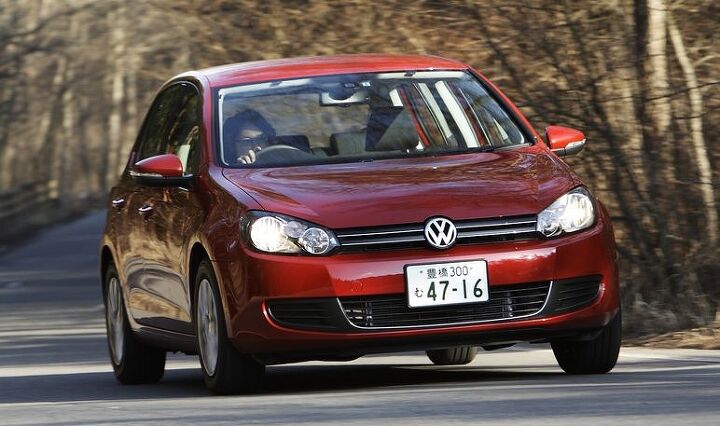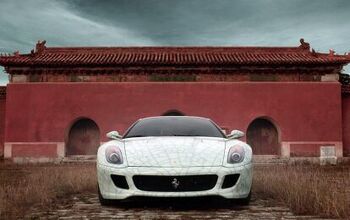Imported Cars Have A Record Year In Japan
Sales of imported cars set a 17 year record in Japan, with brands like Maserati and Volkswagen leading the way, with Bloomberg reporting that non-Japanese brands captured 8.8 percent of non-key car sales – the highest figure since records started being kept in 1989.
Mercedes and Maserati both had record setting years in Japan, while the VW Golf was the best-selling non-Japanese car, ranking 27th overall. The VW Up! is also said to be stealing sales away from kei car shoppers, and the trend of smaller imported cars appears to be a welcome one for Japanese consumers.
Previously, most European brands imported big, expensive luxury sedans, attainable only to the upper strata of Japanese society. Many of these examples were also left-hand drive, which was considered to be a status symbol by many, in the way that a right-hand drive car has enthusiast cachet in North America (and an inconvenience as well – which was arguably part of the appeal).
But the Golf and Up! have demonstrated demand for smaller, imported premium vehicles, and other brands have been following suit. Mercedes is set to begin sales of the A-Class compact hatchback, while Volvo’s V40 small hatch is the brand’s best selling vehicle.
Nevertheless, it’s unlikely that imported vehicles will ever make up a big part of auto markets in Japan. Despite talk of non-tariff barriers and other obstacles, there are significant cultural hurdles to overcome. Certain American vehicles (like muscle cars and large custom vans) have a following among Japanese enthusiasts, but for the vast majority of consumers, American cars are simply too big and too thirsty for Japan. Witness the boom in European vehicles, which didn’t take off in earnest until smaller vehicles became available. Among Japanese auto makers, kei cars are the dominant segment, with smaller cars taking up most of the non-kei share.
Beyond that, Japan is a society where conformity, not individual expression, is considered a virtue. “The nail that sticks up gets hammered down”, is a constant refrain in discussions of Japanese management culture, and what better way to stand out than by buying a vehicle made by the opposing team? Based on that alone, it’s reasonable to conclude that talk of closed markets and non-tariff barriers are secondary
More by Derek Kreindler
Latest Car Reviews
Read moreLatest Product Reviews
Read moreRecent Comments
- Bkojote Allright, actual person who knows trucks here, the article gets it a bit wrong.First off, the Maverick is not at all comparable to a Tacoma just because they're both Hybrids. Or lemme be blunt, the butch-est non-hybrid Maverick Tremor is suitable for 2/10 difficulty trails, a Trailhunter is for about 5/10 or maybe 6/10, just about the upper end of any stock vehicle you're buying from the factory. Aside from a Sasquatch Bronco or Rubicon Jeep Wrangler you're looking at something you're towing back if you want more capability (or perhaps something you /wish/ you were towing back.)Now, where the real world difference should play out is on the trail, where a lot of low speed crawling usually saps efficiency, especially when loaded to the gills. Real world MPG from a 4Runner is about 12-13mpg, So if this loaded-with-overlander-catalog Trailhunter is still pulling in the 20's - or even 18-19, that's a massive improvement.
- Lou_BC "That’s expensive for a midsize pickup" All of the "offroad" midsize trucks fall in that 65k USD range. The ZR2 is probably the cheapest ( without Bison option).
- Lou_BC There are a few in my town. They come out on sunny days. I'd rather spend $29k on a square body Chevy
- Lou_BC I had a 2010 Ford F150 and 2010 Toyota Sienna. The F150 went through 3 sets of brakes and Sienna 2 sets. Similar mileage and 10 year span.4 sets tires on F150. Truck needed a set of rear shocks and front axle seals. The solenoid in the T-case was replaced under warranty. I replaced a "blend door motor" on heater. Sienna needed a water pump and heater blower both on warranty. One TSB then recall on spare tire cable. Has a limp mode due to an engine sensor failure. At 11 years old I had to replace clutch pack in rear diff F150. My ZR2 diesel at 55,000 km. Needs new tires. Duratrac's worn and chewed up. Needed front end alignment (1st time ever on any truck I've owned).Rear brakes worn out. Left pads were to metal. Chevy rear brakes don't like offroad. Weird "inside out" dents in a few spots rear fenders. Typically GM can't really build an offroad truck issue. They won't warranty. Has fender-well liners. Tore off one rear shock protector. Was cheaper to order from GM warehouse through parts supplier than through Chevy dealer. Lots of squeaks and rattles. Infotainment has crashed a few times. Seat heater modual was on recall. One of those post sale retrofit.Local dealer is horrific. If my son can't service or repair it, I'll drive 120 km to the next town. 1st and last Chevy. Love the drivetrain and suspension. Fit and finish mediocre. Dealer sucks.
- MaintenanceCosts You expect everything on Amazon and eBay to be fake, but it's a shame to see fake stuff on Summit Racing. Glad they pulled it.


































Comments
Join the conversation
Chickentaxers are the auto blog equivalent of birthers!
Hello I think,this gonna change our world and creat a new modern japenese world, We european japan car import, Its been also record most japen cars imported here in Uk.I have also bought japen car from the local UK import dealer.